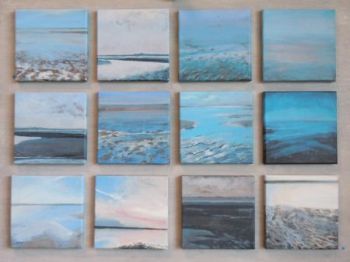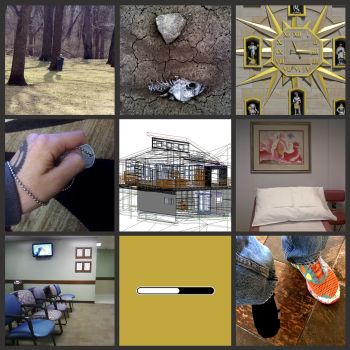Exhibitions

Wadjes (Sigrid Stuut): in Bruinszaal (Academy Building).
Little pieces of art, proudly doing their best to show the beautiful big skies and wide open spaces of the Waddensea area. Because this is such an honourable but difficult task they are with many.
All different, just like the scenery is always changing by weather, tide and time of day. Wadjes love their freedom and are not framed but once separated from each other they prefer a panel or frame to have something to cling to.
Wadjes are helped into existence by artist Sigrid Stuut. She grew up on the island of Terschelling and her love for this island and the spatious Waddensea area is the source of inspiration for her work. To make sure the Wadjes are behaving well she will be at the exhibition area during morning-, lunch- and afternoon breaks. Wadjes and frames or panels will be available for purchase as well.
For more information go visit
http://www.wadjes.nl
The exhibited Wadjes will be for sale by the artist during the conference.
Man en Paard
Comic Man en Paard (Man and his Horse) (Meinte Strikwerda): in room A02 (Academy Building).
Meinte Strikwerda (Mestrik) lives and works in Groningen, as a creative illustrator, graphic designer and teacher (gaming and multi media). His work is being used by a wide variety of companies and businesses. He likes to see his work as 'illustration design': a combination of illustration and graphic design. His passion however is making comics. He is currently working on 'Man en Paard' (the man and his horse) part 3.
Ethnographic sketches
Ethnographic sketches of an asylum seeker centre in the Netherlands (Clemes Bernardt): in the Heymanszaal (Academy Building).
How do asylum-seekers experience in their daily lives the interacting temporal, symbolical and emotional dimensions of the procedural space in which they are received by the Dutch state? And how do they situate themselves within this space? In order to address these questions, Clemens Bernardt has been doing participative observation in an Asylum Seekers Centre (ASC) in the Netherlands. Complementary to a personal research-diary, ethnographic sketches are made to visualise the daily situations within the compound of the ASC, and to discuss them with former inhabitants, without violating their privacy.
Clemens is an architect and lecturer at the Academy of Architecture in Groningen. He is currently working on his PhD at the Radboud Universities of Nijmegen and the University of Groningen.
Emotional Geographies of Groningen
Mapping Emotional Geographies of Groningen by member of the Groningen talent Group: in the Academy Building, room A08
The Conference on Emotional Geographies served as inspiration for a hands-on activity for the members of the Groningen Talent Group (GTG). During one meeting, held at an industrial heritage site in Groningen, the old EMG grain silo, the group met in order to map their own emotional geographies. The products of this exercise are displayed at the conference and printed as postcards and one pocket-size map for conference delegates. The group of mental mappers constists of: Mark Sekuur; Julian Hessels; Johannes Postema; Lena van der Wal; Mariëlle Veldthuis; Ruth Koops van 't Jagt.
The purpose of the Groningen Talent Group (GTG) is, on the one hand, for the municipality and higher education institutions to connect top talents present to each other and to the city. The group is, on the other hand, meant as a think tank for challenges and opportunities within the city of Groningen now and in the future. The City of Groningen, the University of Groningen, the Hanze University and the University Medical Centre selected 80 talented, young people as members of this group.
The workshop and resulting products were funded by the City of Groningen.
Meanwhile in Canada: Industrial Lands and The City.
Photos by Andriko Lozowy at the Academy Building canteen (during the barbecue).
Andriko is a photographer-researcher interested in questions of cameras, photographs, materiality, the intersections of people and places and collaborative methods. Having recently completed a PhD he is optimistic at the possibilities for democratizing knowledge through offering opportunities for others to gain skills through practice. His recent work is centred around Fort McMurray, Alberta, Canada as a site of tension between oil production and the social, in particular the marginalized populations of youth and First Nations people.
"While conducting visual and collaborative research with youth in Northern Canada (Fort McMurray, Alberta) the images produced began to illustrate a stark contrast. As a researcher entering the field, my own naiveté about geo-spatial relations told me that Fort McMurray and the oil sands were one and the same. However, as the images in this series reveal, space is much more clearly delineated, defined and policed than I initially assumed. As the project "Where is Fort McMurray" went on over 3 years (The Camera as a Tool for Assembling Community: Lozowy, Dorow, Shields. 2013 Canadian Journal of Sociology) I continued to offer workshops for youth interested in picturing place as well as photographing on my own to add another perspective to a growing and globalized visual discourse of oil production."
Draw yourself as a building
Participatory exhibition located near the service desk.
The conference organisation has provided an empty canvas in order to facilitate the development of the conference ‘city’. Grab a marker and imagine yourself as a building. Draw and sign! Come back and check out what shape this city takes.
University Museum, Groningen, The Netherlands
In association with the International and Interdisciplinary Conference on Emotional Geographies
Waiting is a constant of the human condition. It has varied temperamental frequencies, emotional volumes, spatial and perceptual dimensions. There is the mundane waiting at the supermarket checkout, the exasperation of a traffic jam, the desperate feeling waiting at the hospital after a medical emergency, the giddy anticipation of a new job offer and the expectancy surrounding pregnancy and the birth of a child.
The Geography of Waiting is a multi-media participatory and interactive installation at the University Museum in association with the International and Interdisciplinary Conference on Emotional Geographies at the University of Groningen. Conceived of and developed by U.S. artists Marguerite Perret, Robin Lasser, Bruce Scherting and Stephanie Lanter, the project explores the abstract, physical and emotional experience of waiting through contributed images and data collected by way of social networks, invitation and open calls. The lead artists will be collaborating with Radio Mobi, an artists collective based in Groningen whose members include Joachim de Vries, Bert Scholten, Rik Möhlmann, Marcel de Vries and Natasha Taylor
If you would like to participate in this project, visit the project Facebook page at https://www.facebook.com/GeoWaiting or read more at the project web page: www.thegeographyofwaiting.weebly.com.
************************************************************************************
SAMPLE CONTRIBUTED NARRATIVES:
~ Waiting for my partner to return from her US ARMY deployment to Korea. Feeling nervous. Denver, Colorado, USA. 9 March 2013, 8:30 pm.
~ Bones of the Lake, Waiting for the Water to Rise. Stone and fish head. Feeling calm. Clinton Lake, Kansas, USA.16 March 2013, 5:05 pm
~ Waiting for the other shoe to drop, global warming, the California state budget, cancer, retirement. Oakland, California, USA. 23 February 2012, 1:01 pm.
~ Waiting for the one special passenger in my life. Topeka, Kansas USA. 13 March 2013, 9:42 am
~ Aquarium in the medical waiting room. What do the fish think about all of this? Feeling ready. Kansas, USA. 1 March 2013
~ Waiting for boarding to go back home and just received word of a dear friend passing away. The children immediately realized mummy wasn't very happy and sat on their chairs till the airplane arrived (1 hour 45 minutes! That is a record.) Very sad. Milan Bergamo Airport, 22 January 2013, 11:00 am
~ Waiting for the Fireflies, Topeka, Kansas, USA, 31 March 2013
~ Waiting is a current theme in my life. I'm in Dhaka, the capital of Bangladesh, right now, and it's a mess. The country's politics are in flux…The practical effect is that the city is wracked with general strikes…It's dangerous to try to travel in anything but a bicycle rickshaw. So I am hemmed more than I like... waiting. For the crisis to end. In truth, the whole country seems to be waiting. Dhaka, Bangladesh. 3 March 2013 ~
Sound plants by Radio Mobi at the Harmony canteen
Radio Mobi and the Emotional Geographies Conference
Radio Mobi will create a special sound environment in the Harmony-canteen during lunch. They will provide ‘sound plants’ for our conference with sounds collected throughout the province of Groningen. Radio Mobi will also contribute to the exhibition on ‘the Geography of Waiting’ at the University Museum.
About Radio Mobi
Radio MOBi is a place that celebrates and questions all things that have to do with sound. It broadcast a monthly 90 min. podcast that explores the interplay Of sound, narrative and its possibilities as a transmittal medium.
The short programs on the podcast vary from radio drama, discussion, sound experiments or the monthly special guest quest to find music for 5 euro’s in the local second-hand shop.
Radio MOBi also creates site-specific sound installations for exhibition areas, festivals and the public space. Radio MOBi’s main focus is creating and providing a platform for a variety of sound experimentation.
The members of Radio MOBi consist of: Rik Möhlmann, Bert Scholten, Natasha Taylor, Joachim de Vries en Marcel de Vries.
www.wijzijn-radio.mobi
| Last modified: | 13 January 2020 10.17 a.m. |
